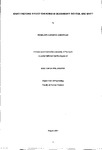WHAT FACTORS AFFECT CHEATING IN SECONDARY SCHOOL AND WHY?
| dc.contributor.author | ARMSTEAD, PENELOPE KATHRYN | |
| dc.contributor.other | School of Psychology | en_US |
| dc.date.accessioned | 2013-09-18T10:55:01Z | |
| dc.date.available | 2013-09-18T10:55:01Z | |
| dc.date.issued | 2001 | |
| dc.identifier | NOT AVAILABLE | en_US |
| dc.identifier.uri | http://hdl.handle.net/10026.1/1840 | |
| dc.description.abstract |
Cheating in British secondary schools has not been previously researched. The aim of this thesis was to ascertain what factors affect cheating in secondary school and why? Initially, four questions were posed: "what is cheating?', "when is it wrong to cheat?', 'what role do parents play' and 'what are teacher perceptions of cheating compared with those of students?'. These questions were addressed by studying the perspectives of students, parents and teachers using a mixture of quantitative and qualitative methodologies, involving nearly 1000 respondents in six studies. Two models were developed. The first, a four dimensional model, explained what students thought cheating was. Cheating was perceived to be comprised of the following interrelated dimensions: non-academic and academic behaviours, a temporal component, assessment events and degrees of severity. The second, a decision model, indicated under what circumstances cheating might be right or wrong. Cheating was wrong for respondents who perceived only negative academic associations, whilst It could be right for others, when motives for cheating were perceived to be honourable. Respondents reported the extent to which they were like students in scenarios who were portrayed to have cheated in a variety of ways. Data from parents and teachers were used to test and amplify these models. Students and teachers held similar perceptions regarding cheating frequency, but not severity. Parents held perceptions of cheating that were more extreme than those of students and teachers. The findings of these studies have major implications for those involved in the wider educational environments of the home, school and society. Recommendations are made regarding cun-ent educational testing policies, the promotion of leaming and the reduction of cheating. | en_US |
| dc.language.iso | en | en_US |
| dc.publisher | University of Plymouth | en_US |
| dc.title | WHAT FACTORS AFFECT CHEATING IN SECONDARY SCHOOL AND WHY? | en_US |
| dc.type | Thesis | |
| plymouth.version | Full version | en_US |
| dc.identifier.doi | http://dx.doi.org/10.24382/3502 | |
| dc.identifier.doi | http://dx.doi.org/10.24382/3502 |
Files in this item
This item appears in the following Collection(s)
-
01 Research Theses Main Collection
Research Theses Main


